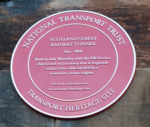Powderhall Stadium
Defunct football venues in ScotlandDefunct greyhound racing venues in the United KingdomDefunct speedway venues in ScotlandDefunct sports venues in ScotlandEdinburgh City F.C. (1928) ... and 8 more
Football venues in EdinburghGreyhound racing in ScotlandLeith Athletic F.C.Motorsport venues in ScotlandScottish Football League venuesSports venues completed in 1927Sports venues in EdinburghUse British English from January 2014

Powderhall Stadium formerly the Powderhall Grounds was a greyhound racing track in Edinburgh, Scotland. It was located on Beaverhall Road, in the Powderhall (Broughton) area of northern Edinburgh, beside the Water of Leith. The track closed in 1995 and the site is now a housing estate.
Excerpt from the Wikipedia article Powderhall Stadium (License: CC BY-SA 3.0, Authors, Images).Powderhall Stadium
Powderhall Rigg, City of Edinburgh New Town/Broughton
Geographical coordinates (GPS) Address Nearby Places Show on map
Geographical coordinates (GPS)
| Latitude | Longitude |
|---|---|
| N 55.9672 ° | E -3.1938 ° |
Address
Powderhall Rigg 7B
EH7 4GG City of Edinburgh, New Town/Broughton
Scotland, United Kingdom
Open on Google Maps







